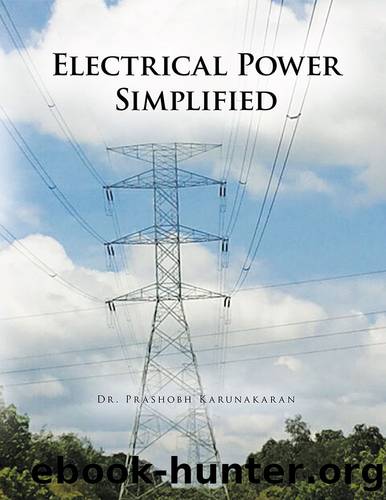Electrical Power Simplified by Dr. Prashobh Karunakaran

Author:Dr. Prashobh Karunakaran
Language: eng
Format: azw3
ISBN: 9781504965439
Publisher: AuthorHouse
Published: 2016-01-06T16:00:00+00:00
Fig. 42: Star-Delta motor starter control circuit
Fig. 43: The Control and Power combined circuit of a Star-Delta motor starter
Autotrans Starter
For the Autotrans circuit in Fig. 44, the names of the three same contactors are changes to L (Line), T (Transformer) and S (Star). The circuit can be understood by looking at one Auto-trans and one motor coil. There are three Auto-trans in one unit of motor starter Auto-trans. Each of these are designed to split each of the three phase voltages L1, L2, L3 (R,Y,B) to 70% initially . That is 70/100 X 120 = 84V (70/100 X 240 =168V). In the second stage (after 6s) the Autotrans is not utilized; the incoming phase wires are directly connected to the motor coils a configuration known as Direct On Line (DOL).
To understand this one Auto-trans and one motor coil is studied. Initially T and S are closed, this will energize the Autotrans. The T will provide L1 (R) phase 240V to the top of the Autotrans coil and the S (above which L1, L2, L3 (R,Y, B) are looped) will provide 0V at the bottom of the Autotrans coil. Thus the wire joint to the 70% point of the coil will provide 70/100 X 120 =84V (70/100 X 240 =168V). This 84V (168V) from L1 (R) phase will go to the one side of a motor coil and another 84V (168V) from Y phase will come from the second Autotrans. With 84V L1 (168V R) phase on one side of the motor coil and 84V L2 (168V Y) phase on the other side of the same motor coil will result on 84√3=145V (168√3 = 290V) across the motor coil.
After 6s, L and S are opened basically taking the Auto-trans from the circuit. And L is closed resulting in 120 V L1 (240V R) phase on one side of the same motor coil and 120V L2 (240Y) phase on the other side of the same coil. This will result in a voltage of 120√3 = 208V (240√3 = 415V) across this motor coil. The control circuit to achieve this is in Fig. 45.
So this motor coil initially experienced 145V (290V) and after 6s it will experience 208V (415V). This is compared with Star-Delta where the motor coil will first experience 120V (240V) and after 6s it will experience 208 (415V). But Autotrans motor controller is smoother for the motor. A 10HP motor can visibly be seen to jump a little with Star-Delta motor starter but not with Autotrans. Primary resistance starters are even more smooth than Autotrans starters. The list of motor starters from least smooth to most smooth are as follows:
1. DOL (Direct On Line) – a MCB is used to energize the motor directly.
2. Star-delta
3. Autotrans
4. Primary-resistance
5. Soft stater using SCR (Silicon Control Rectifier) – mostly used with DC motors.
6. VFD (Variable Frequency Drive) or VSD (Variable Speed Drive) or Inverters using IGBT
Download
This site does not store any files on its server. We only index and link to content provided by other sites. Please contact the content providers to delete copyright contents if any and email us, we'll remove relevant links or contents immediately.
The Art of Coaching Workbook by Elena Aguilar(48034)
Trainspotting by Irvine Welsh(20044)
Twilight of the Idols With the Antichrist and Ecce Homo by Friedrich Nietzsche(17703)
Fangirl by Rainbow Rowell(7825)
Periodization Training for Sports by Tudor Bompa(7323)
Change Your Questions, Change Your Life by Marilee Adams(6637)
This Is How You Lose Her by Junot Diaz(5753)
Grit by Angela Duckworth(4728)
Red Sparrow by Jason Matthews(4654)
Asking the Right Questions: A Guide to Critical Thinking by M. Neil Browne & Stuart M. Keeley(4566)
Paper Towns by Green John(4163)
Room 212 by Kate Stewart(4099)
Ken Follett - World without end by Ken Follett(3968)
The Sports Rules Book by Human Kinetics(3581)
Housekeeping by Marilynne Robinson(3396)
The Motorcycle Diaries by Ernesto Che Guevara(3325)
Introduction to Kinesiology by Shirl J. Hoffman(3297)
Exercise Technique Manual for Resistance Training by National Strength & Conditioning Association(3286)
Double Down (Diary of a Wimpy Kid Book 11) by Jeff Kinney(3267)
